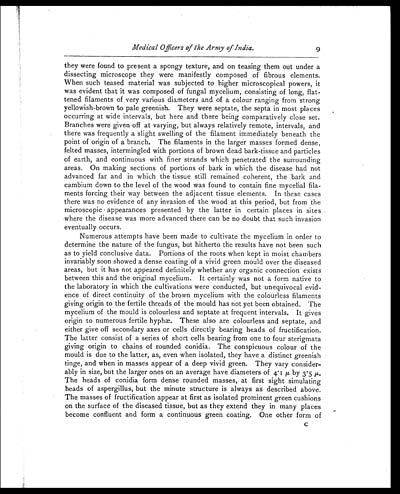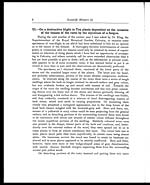Medicine - Institutions > Army health reports and medical documents > Scientific memoirs by medical officers of the Army of India > Part III, 1887 > 1 - Notes from the biological laboratory attached to the Office of the Sanitary Commissioner with the Government of India
(15) Page 9
Download files
Individual page:
Thumbnail gallery: Grid view | List view

9
Medical Officers of the Army of India.
they were found to present a spongy texture, and on teasing them out under a
dissecting microscope they were manifestly composed of fibrous elements.
When such teased material was subjected to higher microscopical powers, it
was evident that it was composed of fungal mycelium, consisting of long, flat-
tened filaments of very various diameters and of a colour ranging from strong
yellowish-brown to pale greenish. They were septate, the septa in most places
occurring at wide intervals, but here and there being comparatively close set.
Branches were given off at varying, but always relatively remote, intervals, and
there was frequently a slight swelling of the filament immediately beneath the
point of origin of a branch. The filaments in the larger masses formed dense,
felted masses, intermingled with portions of brown dead bark-tissue and particles
of earth, and continuous with finer strands which penetrated the surrounding
areas. On making sections of portions of bark in which the disease had not
advanced far and in which the tissue still remained coherent, the bark and
cambium down to the level of the wood was found to contain fine mycelial fila-
ments forcing their way between the adjacent tissue elements. In these cases
there was no evidence of any invasion of the wood at this period, but from the
microscopic appearances presented by the latter in certain places in sites
where the disease was more advanced there can be no doubt that such invasion
eventually occurs.
Numerous attempts have been made to cultivate the mycelium in order to
determine the nature of the fungus, but hitherto the results have not been such
as to yield conclusive data. Portions of the roots when kept in moist chambers
invariably soon showed a dense coating of a vivid green mould over the diseased
areas, but it has not appeared definitely whether any organic connection exists
between this and the original mycelium. It certainly was not a form native to
the laboratory in which the cultivations were conducted, but unequivocal evid-
ence of direct continuity of the brown mycelium with the colourless filaments
giving origin to the fertile threads of the mould has not yet been obtained. The
mycelium of the mould is colourless and septate at frequent intervals. It gives
origin to numerous fertile hyphæ. These also are colourless and septate, and
either give off secondary axes or cells directly bearing heads of fructification.
The latter consist of a series of short cells bearing from one to four sterigmata
giving origin to chains of rounded conidia. The conspicuous colour of the
mould is due to the latter, as, even when isolated, they have a distinct greenish
tinge, and when in masses appear of a deep vivid green. They vary consider-
ably in size, but the larger ones on an average have diameters of 4.1 μ, by 3.5 μ.
The heads of conidia form dense rounded masses, at first sight simulating
heads of aspergillus, but the minute structure is always as described above.
The masses of fructification appear at first as isolated prominent green cushions
on the surface of the diseased tissue, but as they extend they in many places
become confluent and form a continuous green coating. One other form of
C
Set display mode to: Large image | Zoom image | Transcription
Images and transcriptions on this page, including medium image downloads, may be used under the Creative Commons Attribution 4.0 International Licence unless otherwise stated. ![]()
| Permanent URL | https://digital.nls.uk/75004045 |
|---|
| Shelfmark | IP/QB.10 |
|---|---|
| Additional NLS resources: | |




